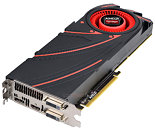If that blower fan and shroud are going to be the face of the card through its production run would it have killed AMD to put some effort into making the card look less generic. A dual or triple fan shroud along the lines of the ACX, DCII, TwinFrozr, or Windforce can't be that hard to engineer surely. I don't think I've ever seen a squirrel cage that outperforms AIB designs.
There's really no in-between to reference and non reference. Adding more fans as you suggested would be equivalent to AMD themselves making it non reference.
The whole point of the blower fan design is to place one fan at the end that blows the exhaust out the back of the case. You can't put more than one fan on a GPU without the added ones being propeller fans that just dissipate vs direct heat, which would just disrupt the airflow of the blower fan, limiting it's ability to exhaust the heat. So at that point you'd be better off just making them ALL prop fans with a non ref HS design.
So ref or non ref, and I prefer a good non ref btw, there's really only one or the other.
On a side note, an interesting and relating bit of trivia. I once asked EVGA if they'd ever make any non ref cooled video cards. At that time they said they had no plans to. Shortly after, they launched their first non ref cards. I then asked about one of the new models that was non ref, to see if they'd sent out any samples for review. The guy I spoke to insisted it would have roughly the same performance as their ref card, despite my suggesting their claimed 20c cooler temps might make it more OCable. His answer was that they only refer to stock speeds, making it clear they don't care about what is said regarding OC ability in reviews. Perhaps because it varies from card to card. EVGA is very conservative in stating their specs after all.
Anyways, regarding ref vs non ref, obviously non ref has proven to be cooler (and quieter). I think the only reason they launch cards like these ref only is they need to be sure they'll get enough orders before they commit to the vendors that want to build such types, and that in turn can depend on the yields they (Nvidia and AMD) get with the chips. That might also mean AMD will authorize non ref designs much sooner than Nvidia on their Titan, because it will probably be priced a lot lower knowing them. Then again, AMD's customers are used to low prices, so it will depend on how low they can offer it at launch, AND how good their yields are of course.
We're getting to the point now where between the die size and sheer power of these chips, the yield issue alone is more significant than it used to be. They're going to reach a saturation point with die shrinking unless the chip manufacturers can somehow make the process easier. I know Intel invested heavily in the use of Hafnium, and AMD even mocked their use of it once, but we all know Intel is the king of die shrinking.












